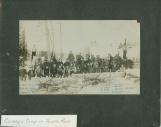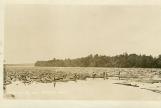2
The Essence of development in the Massey Area can be expressed in two words- pine sawlogs. This is true for the most of the North Shore of Lake Huron. Throughout the North Shore development of the sawlog industry was shaped by two great vehicles, the rivers and the railroad. In the Massey area the rivers are the Sables, which flows through the National Chutes Park, and the Spanish River, which borders the town on the south and receives the flow of the Aux Sable.In 1865, the first lumber company (Cashing and Glover Lumber Company) set up camp North of what wouod become the Town of Massey. During the logging boom, there were a total of seven lumber companies operating in the area. The logging boom brought large but short lived benefits to the town through direct spending and employment, as well as through creation of additional work such as sorting and sawing logs.
4
The Chutes Provincial Park was established by the Department of Lands and Forests in 1961. Each year the park attracts many tourists. It is the only Provincial park between Sudbury and Sault Ste Marie, Ontario. The park is named after the large wooden chute that was used to divert logs sround the waterfall in the early logging days (1870s through 1929. The park offers 130 Sites and several kilometers of hiking trails, which include two bridges, three viewing platforms, and a view beyond compare. There is also a picnic area and beautiful beach to enjoy on those lazy summer days.6
Records tell us that in 1865 a raft of pine logs arrived in Montreal from the Spanish River. This is the earliest account of logging in the area. From that time onward, logging became a driving force in the settlement and growth of the area. The Spanish and Sauble Rivers provided easy water transport for logs and by the mid 1800s the Cashin and Glover Lumber Company had set up camp North of Massey, although no town exisaited at that time. A lumbering tote road was built Northward and parallel to the Sauble River.More lumbering companies followed and at least seven different companies established their headquarters around the mouth of the Sauble River. Logs were cut all winter and each spring logs were stamped with the company's mark and dumped into the Sauble where they floated down to the Spanish River to be sorted and shipped off to American and Eastern Markets.
8
During the 1917-1918 season, about 2000 bush workers were employed in the lumber camps around Massey. In the early days, the salary for these men was $26 per month plus Room and Board, provided they worked for the whole season which was seven months. If a man did not work the whole season, his wages were cut to $15 or $20 per month depending upon how he had performed in the bush for the company. Boys as young as 11 or 12 years of age worked toting supplies from the base camp at Massey to the logging camps.Logging is still a part of the area as these lumber transports demonstrate.




